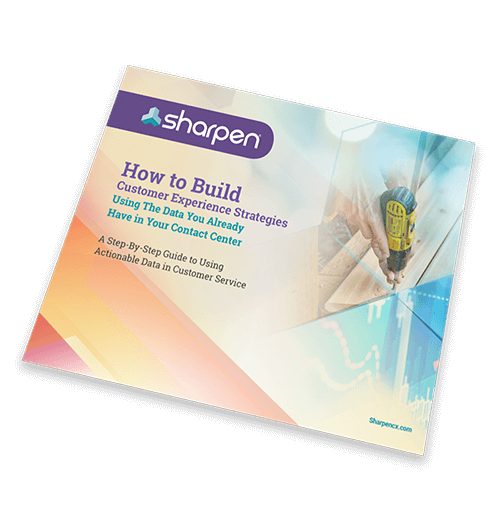
How to Take Action and Deliver Better Customer Service (While Helping Your Agents Excel)
How do you react when you have a bad day? And what about when you feel out of the loop or under appreciated at work? If you’re anything like me, you probably don’t feel like talking to a bunch of people. And you certainly don’t have the energy (or the grace) to help people with their problems. You’re dealing with plenty of your own.
When I have a bad day, I stay silent. I stop cracking jokes and do my best to avoid human interaction. I have a shell I (un)happily retreat to. And on the really bad days? Well, it’s clear to everyone I talk to that I need a little uplifting. After all, I’m human.
And so are your agents.
The key to delivering better customer service sits right in front of us. But so many people still miss it. When your agents are down in the dumps, your customers get bad service. Period.
Agents need to know and understand their goals and their progress to succeed and be happy at work. And, they need the right tools and support from leaders to keep well-being high. Investing in your agents is the only path to better customer service. Here are three ways to take action and support your agents, so they can deliver better service for customers.
1. Use customer and agent data to improve call center performance and deliver better customer service
Your data shows you the landscape of your customer experience. It shows you how your people, processes, and technology all sync up to create your customer journey.
Data is the nucleus of your call center – living at the center of your decision-making and the improvements you make to your customer experience. Don’t just let it sit stagnant in your reporting engine. Instead, use your data to deliver better customer service and improve agent performance. Here’s how.
Use your customer service data for better experiences by:
- Setting performance standards for your agents
- Choosing KPIs that align with your goals
- Making sure agents understand the “why” behind their metrics
- Surfacing metrics daily to incrementally improve service a day at a time
- Using metrics and tangible data to identify and address agent performance
- Share the value and progress of your contact center other stakeholders
Your agents need clear goals that align with customer outcomes. And, they need a way to measure and track their performance against those goals, so they can keep delivering better customer service.
Turns out, clear expectations are the most fundamental employee need, according to Gallup. And, agents who don’t have daily visibility into their metrics are at an increased risk for burnout.
When agents see their performance data day after day (and interaction after interaction), they feel motivated to do better.
It’s the same reason we set targets for one quarter then make them harder to reach the next. The more we crush our goals, the higher we raise the bar. People are motivated by success. Agents will compare their performance to the day before and want to grow – improving your service levels and ROI along the way.
There’s more, too. When agents know how they perform against their peers, they want to beat them, triggering a race for top performer (and better service for your customers). Nobody likes coming in last place.
2. Coach often using what you learn from your call center data
Now, take all that performance data you’ve collected, and do something with it. Showing up to performance conversations with tangible data gives agents a clear understanding of where to improve. Then, turning that data into actionable and relevant feedback for your team gives agents context for how to improve.
Plus, coaching your agents with developmental feedback also lowers agent turnover rates and builds trust. The more your agents trust you, the easier it is to have future performance conversations. Even the tough ones. When you can have the tough but necessary conversations with your team members, that’s when they’re able to turn constructive feedback into action and deliver better customer service.
[Read Next] 4 tips to retain top employees in a world where burnout consumes us
Keep these tips top of mind as you coach your agents:
- Why do agents struggle? Look beyond the surface to find out. Are they stuck jumping through hoops every time they talk to a customer? Can they access and find the customer data they need? Do they understand their performance expectations?
- Talk about performance standards and address agents who aren’t meeting those standards in 1:1s. But, don’t just reprimand them for a few missed metrics. Balance praise and constructive feedback (with action items) to motivate agents to improve performance.
- Your agents can’t fly solo and improve performance. They need support and an action plan from you to make the biggest gains.
3. Connect with your customers where and how they like to communicate
Last year more than 86% of customers said they expect conversations with agents to move seamlessly between channels, no matter how they reach out to your company for help. And next year, 70% of all companies will accelerate digital projects to help meet these customer expectations.
When you don’t meet customer expectations, they show up to conversations with your agents already frustrated. Your agents take the heat for that unanswered email or the Tweet that’s floating around the Twitterverse with no reply. That anger consumes your agents and leads to an unproductive interaction, plus a drop in morale, punishing your future customers, too.
Your customers are everywhere. Meet them there with an omnichannel strategy. It’ll help your agents, too.
An omnichannel customer experience can help your team:
- Monitor for and answer customer questions on social media channels, like Twitter and Facebook.
Customers who turn to their social media megaphones are begging for help. So, help them. Use omnichannel tools in your contact center to monitor for customer callouts on platforms like Twitter and Facebook. Then, route these interactions to your agents’ queue just like you would with a phone call or email. That way your agents get all their interactions in one place, so they can always send a timely response.
[Read Next] 7 strategies to take your social media support to the next level
- Solve customer issues faster with web chat and automation
Some 80% of customers say fast customer service is one of the most important pieces of a positive experience. Fast service channels, like web chat, help your customers resolve issues in minutes instead of hours.Then, pairing chat with automation and bots helps resolve issues with even less effort. You can set triggers to direct customers to bots and automated workflows that handle simple (or repetitive) questions for your agents. You free up your agents’ capacity for deep work and you save your customers time and headaches in the process.
- Share customer data with agents during interactions, so they stay informed.
An omnichannel strategy isn’t just about channels. It’s about connecting all your systems, like your CRM, knowledge base, and ticketing system, too. Modern omnichannel strategies knock down information silos for your team, so they have access to all the info they need to deliver better customer service.
[Download Now] Use your data to build customer experiences your customers actually want


